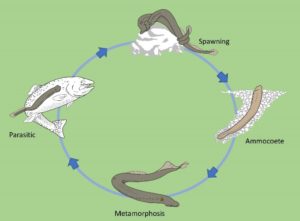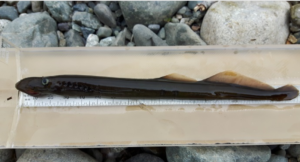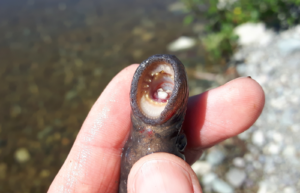Did you know there is a species of fish in our watershed that is found nowhere else on earth?
The Cowichan Lake lamprey is a parasitic fish species found only in Mesachie, Bear, and Cowichan lake which dates back at least 350 million years. Lamprey have an amazing life cycle, where they spend most of their life as an ammocoete (larval form of lamprey). In some species, this may last more than 6 years! Ammocoetes are blind filter feeders who spend most of the time burrowed in the sediment with only their mouths sticking out, eating food as it floats by. For Cowichan Lake lamprey, after the ammocoete phase is finished they undergo metamorphosis and are then capable of feeding parasitically on other fish in the lakes. Their life cycle is complete with nest building and spawning in the sand bars where creeks empty into the lake. Both males and females tend nests before spawning in either pairs or groups. Lamprey are called terminal spawners and spawn only once before dying.
Scientists know that siltation from poor land use practices threatens lamprey habitat. Another threat to lamprey is the fact that coho, one of the Cowichan lampreys’ primary food sources, have declined drastically. We also know that the Cowichan lamprey is a native species. It belongs here. It’s part of an amazing ecosystem that is composed of species that have evolved together –right here where we have chosen to live. As a threatened species, it is illegal to kill, harm, harass, capture or take the Cowichan lamprey. Collectively we need to protect it. Its future is in our hands!

Figure 1. Lifecycle of the Cowichan Lake lamprey.
Click here for a link to a video of the Cowichan Lake lamprey building a nest and spawning. This amazing feat of nature is rarely seen!
If you would like to learn more about the is unique creature please set up a time to come visit the CENC. For a limited time we have an interactive Cowichan Lake lamprey display in the Cowichan Estuary Nature Centre. While the centre is closed to the public, we would be happy to accommodate your visit to see the display and learn more about this amazing creature. Please email or call us to set up a visit.
Thank you to both Joy Wade and Genevieve Singleton for sharing your enthusiasm and knowledge about Lamprey!




